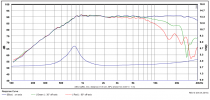@lashto
Before I post it, I want to make sure that we're generating the correct files. Based upon both Audacity and Distort, the simple act of generating 22,33,and 44 kHz tones leads to mathematical harmonics in the single digit kHz range.
I wanted to have a "carrier" 11 kHz -- but you don't even need that.
If this happens with the math, then the electrical signal is being asked play 22/33/44 and the resulting signal has 1 kHz tones...
That is, with 3 tracks I have this. The 3 individual signals are shown
View attachment 263677
Merge it to 192 or 384 kHz single file, and it *looks* and *sounds* like this
View attachment 263678
Export it to 358 kHz and you get this:
View attachment 263681
I'm not actually trying to test the missing fundamental with actual expected harmonics.
The question originated
1) we know that you can fake extra bass by playing frequencies at the harmonics where the bass "should have been."
2) we wondered if you took a 22 kHz sine wave (which no one can hear), a 33 kHz sine wave (which no one can hear), and then a 44 kHz sine wave (which no one can hear) and then put all 3 together, would you hear something?
And it seems like the software that isn't professional is generating a lot of IMD? PMA is able to combine those files without any issues?
--------
@pma, can you generate a file with no 11 kHz -- just 22/33/44?
@pkane and
@pma
Does this have any implications for real-world DACs? If you feed it 22/33/44 could they generate the same problems we see with the software tools?

